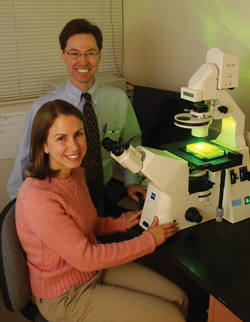
A reovirus study by Terence Dermody, M.D., Melissa Maginnis, graduate student, and colleagues appeared in the Journal of Virology, right.
Photo by Dana Johnson
Investigators track virus’ ability to ‘sneak’ into cells
Vanderbilt University Medical Center investigators have discovered another member of the back-and-forth discussion that happens when reovirus infects its cellular targets.
“The virus and the cell engage in an 'I'm okay — you're okay' interaction that ultimately tricks the cell into taking the virus in and allowing it to replicate,” said Terence Dermody, M.D.
“This is an interaction of major importance for determining why a virus chooses a particular site in the body to infect and cause disease.”
Dermody and his colleagues in the Lamb Center for Pediatric Research reported in the March 15 issue of the Journal of Virology that the protein beta-1 integrin serves as an internalization receptor for reovirus.
Reoviruses are a family of viruses that infect most mammals, including humans, and are relatively harmless, except in newborn animals where they can cause serious disease.
They make useful models for studying viral infections in cell culture and in laboratory animals.
“We think that some of the mechanisms used by all pathogens — not just viruses — to target cells within the infected host and reprogram the machinery of the cell might be conserved,” Dermody said.
“So the principles we uncover with our studies of reovirus might provide clues about how other pathogens cause disease and illuminate new approaches for development of vaccines or anti-viral therapies.”
Several years ago, Dermody's team identified JAM-A — junctional adhesion molecule-A — as a binding receptor for reovirus. Subsequent experiments demonstrated that JAM-A serves as a docking port for reovirus, but that it alone is not sufficient for viral entry into the cell.
To find a suspected “co-receptor” that mediates viral entry, the researchers took a hint from adenoviruses. Though adenoviruses are unrelated to reoviruses, the two virus families have remarkable structural similarities in their attachment proteins and cellular binding receptors.
Adenoviruses find their way into cells by engaging integrin proteins.
“Based on these surprising structural similarities, we had been thinking about integrins as possible co-receptors for reovirus even before we learned that JAM-A is not directly involved in reovirus internalization,” Dermody said.
Melissa S. Maginnis, a graduate student who is the first author of the current study, analyzed the reovirus outer coat proteins for sequences that might mediate integrin binding.
After finding highly conserved integrin-binding sequences, she performed a series of experiments to demonstrate that beta-1 integrin serves as an internalization receptor for reovirus.
“These findings extend the conserved attachment strategies of adenoviruses and reoviruses to mechanisms of internalization, suggesting that the two seemingly unrelated viruses share a common ancestry,” Maginnis said.
“Identifying a new receptor for reovirus is very exciting for our laboratory,” Dermody said. “It not only explains how reoviruses are internalized, it also leads to many new questions.”
Among those questions are: how do the virus and receptor physically interact, what underlying biochemical mechanism leads to internalization, and what cellular genes are activated by this binding event?
Reovirus, it turns out, offers “a useful tool to study the cell biology of molecules such as JAMs and integrins to learn how these molecules signal in the cell during normal cellular processes,” Maginnis said.
“We think that viruses like reovirus have selected their receptors in part to induce the expression of cellular genes that make the cell more permissive,” Dermody added. “What are those genes? Are they involved in cell proliferation, in cell death? Are they altered in cancer?
“Studies of viruses like reovirus help us better understand how cells normally work, and that understanding might have relevance to a large group of diseases in addition to infectious diseases.”
J. Craig Forrest, Ph.D., a former graduate student in the Dermody group, was a co-first author of the current report. Other Vanderbilt contributors include Sarah Kopecky-Bromberg, Ph.D., S. Kent Dickeson, Ph.D., Samuel Santoro, M.D., and Mary Zutter, M.D.
The research was supported by the National Institutes of Health and the Elizabeth B. Lamb Center for Pediatric Research.
— Dermody is professor of Pediatrics and Microbiology & Immunology and director of the Vanderbilt Medical Scientist Training Program













